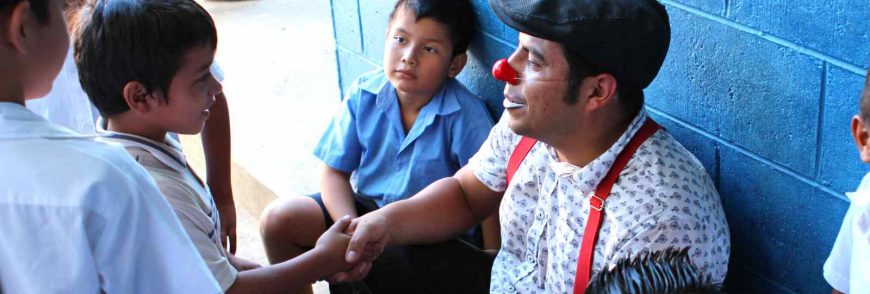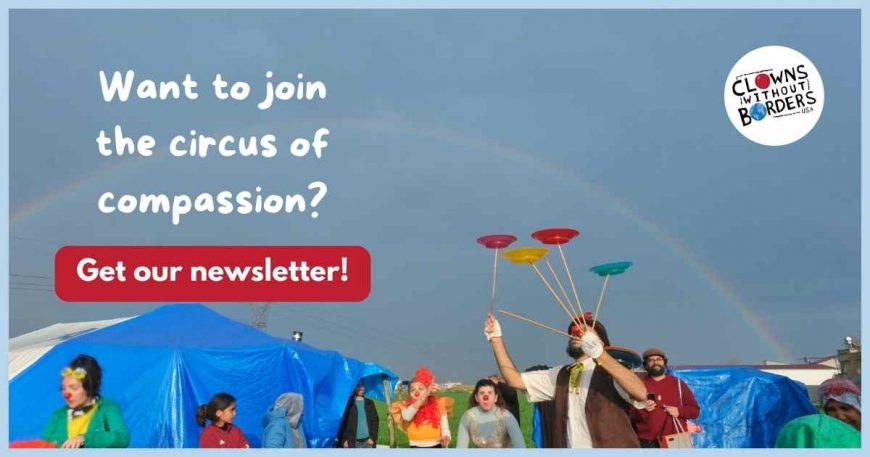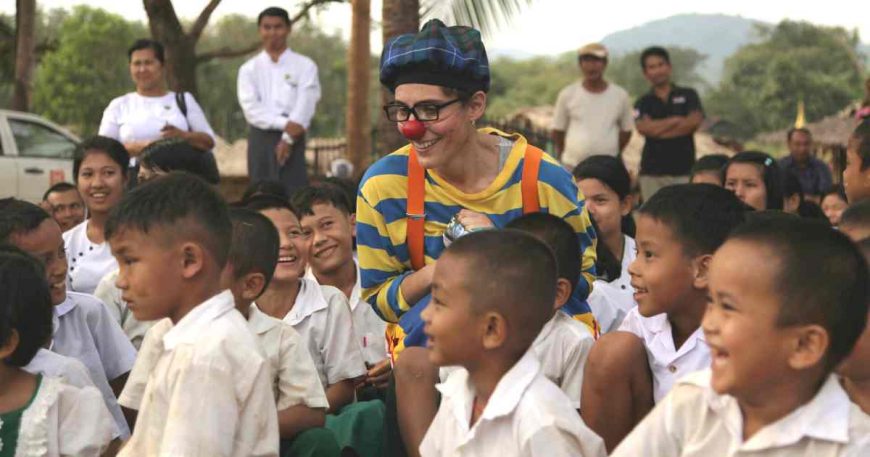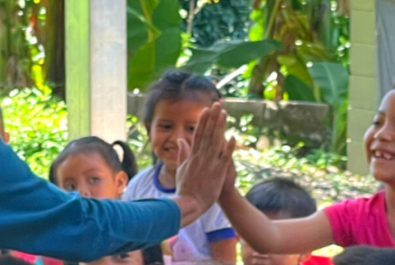Check out our April 20-28 tour in the Bay Area of the United States!

What Does Internally Displaced Person (IDP) Mean?
Aid organizations often can’t help IDPs because of unsafe conditions. For these reasons and others you’ll read about in this post, Former UN Secretary General Kofi Annan has called IDPs, “among the most vulnerable of the human family.”
Read to the end of the post for information, photos, and a video about IDP communities Clowns Without Borders-USA has supported.
Who are Internally Displaced People (IDPs)?
Do you know someone displaced due to conflict or natural disaster?
The number of IDPs across the world has been increasing for some time, but in 2022, the population of this group jumped to the highest level ever.
By the end of 2022, people displaced from their homes worldwide reached 71.1 million, with 88% displaced because of conflict and violence. Disasters caused the displacement of the remaining 22%.
Note: Data in this post is from the Internal Displacement Monitoring Centre’s GRID 2023 Report unless otherwise noted.
Who are Internally Displaced People (IDPs)? by Maggie Cunha
Where are IDPs?
Internal displacement occurs worldwide.
At the end of 2022, sub-Saharan Africa accounted for 45% of the world’s total IDPs, with nearly 6 million in Democratic Republic of the Congo and 4.6 million in Ethiopia.
The Middle East and North Africa join sub-Saharan Africa as regions with the most IDPs in the world (18%). Syria had almost 7 million IDPs by the end of 2022 and Yemen had 4.5 million IDPs.
The war in Ukraine has caused the internal displacement of 5.9 million people.

IDPs and Urbanization
Most IDPs live outside formal camps, separating them from most humanitarian services. In urban areas, IDPs may have better access to education, housing, and healthcare services if discriminatory laws don’t block that path.
Another challenge IDPs may need to navigate? The people who already live in urban areas.
Urban residents may see an influx of IDPs as competition for housing or jobs. This can lead to harassment, discrimination, or violence.
FAQs: Frequently Asked Questions About IDPs
What does IDP stand for?
IDP = Internally Displaced Person. IDPs = Internally Displaced People.
What is an internally displaced person? Who are internally displaced persons?
A simple definition of IDP is from Wikipedia: “An internally displaced person (IDP) is someone who is forced to leave their home but who remains within their country’s borders.”
You may feel challenged to see internally displaced people (IDPs) as more than a distant, nameless group of people who you have nothing in common with.
But, at CWB, our supporters journey with us to where IDPs live, work, and play. We meet people, learn their names, and offer games — many, many games. Children and families connect through the magic of play and laughter.
And we share their stories.

Are internally displaced persons (IDPs) refugees?
No, IDPs are not refugees.
To be considered a refugee, a person must cross their national border. If a family has the same experience as their neighbor but doesn’t leave the country, they will not have the chance to become a refugee. The neighbor that crosses the border has the chance to become a refugee.
Unlike refugees, internally displaced people, or IDPs, do not have a special status in international law. “Internally displaced person” is a descriptive term that does not come with rights or privileges.
What challenges do internally displaced persons (IDPs) face?
IDPs face many challenges:
- IDPs leave their home, and so leave behind a job, property, and livelihood
- IDPs are often out of reach of international aid organizations
- IDPs may not eat regular meals
- IDPs may get injured or lose loved ones to violence
- IDPs must rely on their government for support, which may not come
- There are more IDPs than refugees (over 2x), but receive less global attention
- International law does not protect IDPs from violence or persecution

What rights do internally displaced persons have?
Internally displaced people, or IDPs, have the right to the same freedoms and rights as everyone else in their country. However, a crisis may limit those rights, especially if the government responsible for protecting IDPs is also persecuting them.
Unlike refugees, IDPs lack protection under international law. The United Nations’ Guiding Principles on Internal Displacement sets out government responsibilities toward IDPs, but it’s not international law.
Below are documents for further reading.
- African Union Convention for the Protection and Assistance of Internally Displaced Persons in Africa (“Kampala Convention”), 22 October 2009
- International Standards Relating to Internal Displacement
What are the causes of internally displaced persons (IDPs)?
Conflict or violence forces 88% of IDPs to leave their homes, while natural disasters like storms, droughts, fires, or floods displace the remaining 22%.
What are the needs of internally displaced persons (IDPs)?
IDPs’ needs may include food, shelter, healthcare, education, and childcare. However, getting help to IDP communities may be difficult for aid organizations because of dangerous routes.
The good news? Informing yourself about your government’s policies toward international conflicts can help IDPs. This is especially true when your government knows that you care about IDPs enough to affect the way you vote and contribute to civic life in your home country.

What are the examples of IDPs?
Great question!
Clowns Without Borders has gone to many IDP communities.
In the last section of this post, you’ll learn about people from IDP communities we’ve supported (including tour photos, videos, and links to blog posts).
IDPs and Clowns Without Borders (CWB) – USA
Clowns Without Borders-USA has supported IDPs across the globe. For a larger sample of our work, check out our blog.
The Middle East
Iraqi Kurdistan is an autonomous region in northern Iraq where stateless Kurdish refugees and IDPs represent about 28% of the population. CWB toured the region twice in 2022 to establish a new partnership.
“The children were constantly worried that a new bomb attack would hit, making it hard for the kids to focus on something else. It was hard to find a child who laughed.”
Human Rights Lawyer Tara Azizi on why she reached out to CWB, 2022
East Asia
There are currently 1.5 million IDPs in Myanmar. CWB toured here in 2018, performing a mine safety show for internally displaced children in partnership with Mines Advisory Group. This video is a taste of the project.
The Americas
Agricultural intrusions onto their lands constantly threaten Indigenous communities of Southern Brazil. CWB exchanged art with the Guarani people in 2019 and again in 2022.
Colombia is currently home to 4.8 million IDPs. Here, CWB toured 10 times since 2009, most recently connecting with youth who are at risk for gang recruitment.
In El Salvador and Guatemala, CWB laughed and played with IDP families who fled their homes because of violence or climate disasters.
“Thank you for bringing us laughter. The community needed it.
Thank you for being professional and different.”
– Ken, a grandfather from the audience Guatemala, 2022

Conclusion
You can help internally displaced people, or IDPs, by connecting with organizations that support them.
At CWB, we share the faces (often smiling and laughing) we meet on tour with our supporters. Because people connect with people, not statistics.
If you’d like to hear stories about displaced people regularly, join us by signing up for our weekly newsletter!



